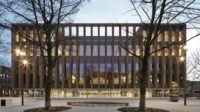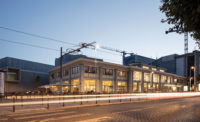His 1999 Courtyard Houses in Matosnhos, near Porto, with their high walls and interior courts and gardens, look like closed warehouse blocks from the outside, and could be seen to adhere to the severe restraint of Mies van der Rohe’s court-house typology in order to elude any trace of Siza's Baroque modernist lyricism. But in more recent works, including the 2004 Braga Soccer Stadium, the 2007 Burgo Tower in Porto, and the 2009 Paula Rêgo Museum in Cascais, all in Portugal, he has broken free of a strictly Miesian model without renouncing the strong, closed geometric forms, the honest use of materials, especially concrete, and the innate restraint of his early work, which allows his buildings to enter into dialogue with their surroundings.
One of the first projects in which this expressive silence finds a powerful voice is his 1997 conversion of the ruined Portuguese monastery of Santa María do Bouro into a state hotel (RECORD, November 1998, p. 120). The finished building, I wrote at the time, “is full of echoes of its former abandon: the flat roofs overhung with bits of vegetation, the roofless cloister, the dark window openings, some with their sky-blue blackout shades drawn as if bits of sky could still be seen through the structure.”
In its press statement, the jury for the Pritzker Prize describes the architect’s work as follows: “Eduardo Souto de Moura's architecture it is not obvious, frivolous, or picturesque. It is imbued with intelligence and seriousness. His work requires an intense encounter, not a quick glance. And like poetry, it is able to communicate emotionally to those who take the time to listen. ... His oeuvre is convincing proof of the modern idiom’s expressive potential and adaptability to distinct local situations."
In giving the prize to Souto de Moura, the Pritzker jury, headed by Lord Peter Palumbo and including previous laureates Renzo Piano and Glenn Murcutt, continues the trend marked by the two previous years, when the award went to Swiss architect Peter Zumthor (2009) and the Japanese team of Kazuyo Sejima and Ryue Nishizawa (2010). The selection of Souto de Moura confirms the jury's promotion of architects who explore the more intimate and poetic qualities of architecture, as opposed to the extroverted formal experimentation that has marked the most conspicuous world architecture leading up to the financial crisis of 2008.
The message of the Prize this year is thus clear. And as in prior years, the jury’s choice has not failed to surprise many, as it should if the Pritzker aspires to have any impact on the public’s perception of architecture or on the direction of the profession globally. The award also catches Souto de Moura at a crossroads in his development, at a time when he has begun to open his work to new dimensions, as the formal variety of his most recent work demonstrates. It thus finds him at an ideal moment to make positive use of the worldwide attention it brings.






















Post a comment to this article
Report Abusive Comment